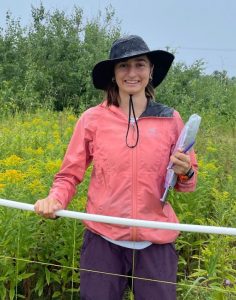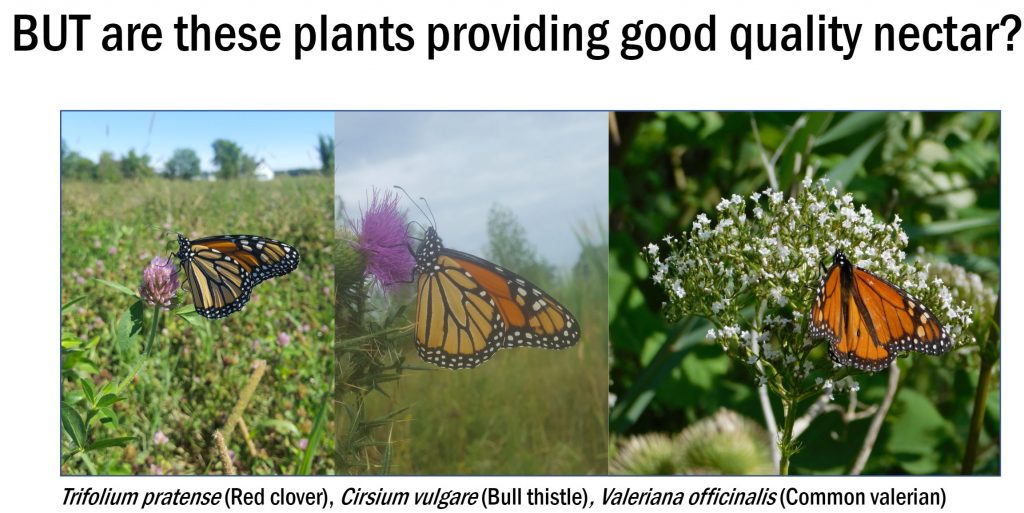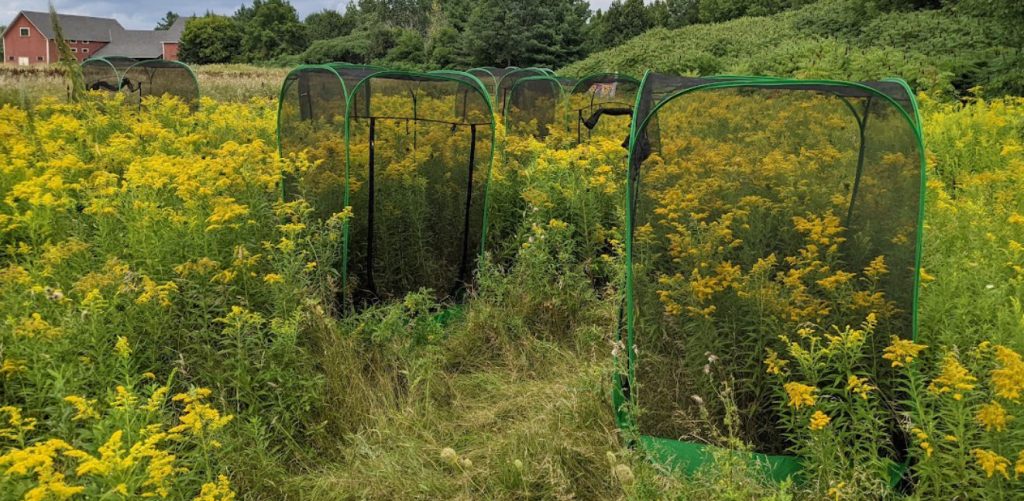By Heather Kharouba, with thanks to Zoe Pekos, Manon Veselovsky, Steph Rivest, and Greg Mitchell for their work on the project
Are Ottawa’s native butterflies feeding on nectar from non-native plants?
We sought to explore this question, following some interesting patterns we recently observed while conducting research in the Garry Oak Ecosystem on Vancouver Island.
To address this question, we attempted to determine the extent to which non-native plants dominate the meadow habitats around Ottawa, and how Monarch butterflies, in particular, are using non-native plants for nectar.
Last summer, Zoe and Manon, students in my lab, undertook two ambitious projects at the same time. Zoe and her field assistants did weekly surveys of Monarchs nectar-foraging and tracked the amount of floral resources available to them. They visited 10 sites in the Greenbelt around Ottawa. We were particularly interested in whether there was any seasonal pattern in the availability of non-native flowers. To figure this out, Zoe tried to choose sites that were as similar to each other as possible.
After tracking Monarchs for 3 months, Zoe found was that they frequently visited non-native plants for nectar. In fact, 58% of all their foraging visits were to non-native plants! Removing visits to Common Milkweed (their larval host plant) from the calculation increases this number to 81%. This suggests that non-native nectar makes up a large proportion of their diet.
We also found that the relative availability of native nectar increases through the season. This means that if we want to remove non-native plants, focusing on those that flower later in the season may have less impact on the total nectar available for native butterflies.
What we still don’t know is whether non-native plants provide good-quality nectar. If they don’t, then non-native plants might constitute a developmental trap for Monarchs — poor-quality nectar may have negative impacts on their growth. And we may have to re-think our approach to non-native plants.
As a first step toward figuring out whether non-native nectar is of poor quality, we asked more generally whether different plant species provide different quality nectar to Monarchs. To do this, Manon and her research assistants conducted a feeding experiment last summer. She collected Monarch eggs and young larvae from sites around Ottawa, reared them in controlled environmental conditions at the university, and then released each adult into an enclosure that was set up in a greenhouse with a flowering plant. After a lot of wrangling and troubleshooting with different plant species, she ended up with healthy plants from 7 species that were all flowering at the same time: Oxeye Sunflower, White Heath Aster, Tall Goldenrod, Butterfly Bush, Black-eyed Susan, Purple Coneflower, and Spotted Joe-Pye-weed.
Given difficulties growing some of the plants in the greenhouse, Manon also ended up running a 2nd smaller experiment in the field at the Fletcher Wildlife Garden. You can learn more about her experimental setup from a CBC radio interview: Study investigates favoured fall menu of Monarch butterflies (In Town and Out, 10 September 2022).
Deciding which plants to use in the experiment was a big decision. Manon chose plant species on which Monarchs were frequently observed and photographed by contributors to iNaturalist. She also chose plants that flowered later in the season so that we could figure out the impact of these nectar sources on energy acquisition of the Monarchs heading south to Mexico in the fall.
After measuring how much weight change the Monarchs experienced during her experiments, Manon has figured out that the 6 native species in her experiment did not differ significantly in their nectar — at least based on weight changes in the butterflies. We have yet to analyze the nectar quality directly (e.g., for glucose concentrations). We also want to measure how much fat the adults accumulated over the experiment.
The first results from the experiment suggest good news for restoration activities. It means that we may not need to worry too much about the identify of the species that go into the seed mixes used for restoration: they are likely providing a similar benefit to Monarchs.
As with all research, the work we we did last summer has led to more questions. How does non-native nectar compare to native nectar? How will climate warming affect nectar quality? How might nectar quality vary across different habitat types? Can we apply the patterns we found for Monarchs to more efficient pollinators like native bees?
We are hoping to answer some of these questions this summer, so stay tuned!
If you have any thoughts or questions about our work, please get in touch: heather.kharouba@uottawa.ca
If you want to learn more about our research, please check out our website: kharoubalab.weekly.com
Heather Kharouba is an associate professor in the Department of Biology at the University of Ottawa.




I would appreciate hearing more about your experiments. I am a member of the Monarch Teacher Network and like you, am trying to increase our numbers here. I am intrigued about nectar amount and quality. Please keep me posted, thanks….Mary